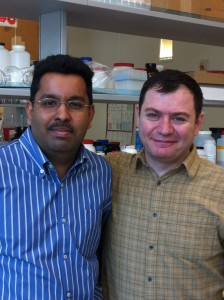Red blood cell (RBC) transfusions are vital for the treatment of a number of acute and chronic medical problems. Identification of donor RBCs that match the prospective recipient who requires transfusion is occasionally difficult, placing the patient at risk if a match is not available. At present no method is available for the generation of universal red blood donor cells in part because of the daunting challenge presented by the multitude of antigens (308 known antigens) on the RBC surface. However, the development of universal donor RBCs would significantly improve transfusion safety, thereby justifying research in the field.
 Supervised by CBR member Dr. Jay Kizhakkedathu, Rafi Chapanian et al (Biomaterials 2012, 33(10):3047-57) reported a novel method of “functionalizing” the RBC surface with globular hyperbranched polyglycerol (HPG) polymers, effectively masking the cell-surface antigens, thereby creating RBCs that would hopefully escape immune clearance. They tested different size HPGs and showed that across a wide range, the modified RBCs remained intact in vitro, and were resistant to immune-mediated destruction. Rafi and his colleagues then radiolabelled the HPGs that were grafted to the RBCs and used in vivo mouse models to measure clearance. They clearly showed that the modified RBCs had a normal life-span in the circulation (approximately 50 days) and that they were subsequently removed by normal clearance mechanisms in the liver and spleen.
Supervised by CBR member Dr. Jay Kizhakkedathu, Rafi Chapanian et al (Biomaterials 2012, 33(10):3047-57) reported a novel method of “functionalizing” the RBC surface with globular hyperbranched polyglycerol (HPG) polymers, effectively masking the cell-surface antigens, thereby creating RBCs that would hopefully escape immune clearance. They tested different size HPGs and showed that across a wide range, the modified RBCs remained intact in vitro, and were resistant to immune-mediated destruction. Rafi and his colleagues then radiolabelled the HPGs that were grafted to the RBCs and used in vivo mouse models to measure clearance. They clearly showed that the modified RBCs had a normal life-span in the circulation (approximately 50 days) and that they were subsequently removed by normal clearance mechanisms in the liver and spleen.
These are particularly exciting findings for at least 2 important reasons. First, they describe a relatively simple means of generating universal donor RBCs that retain their properties. Second, the HPGs can also be linked to drugs, and in combination may be an approach for the targeted and controlled delivery of therapeutics using RBCs as the carrier.
To read the whole story, please click here!



Comments are closed, but trackbacks and pingbacks are open.